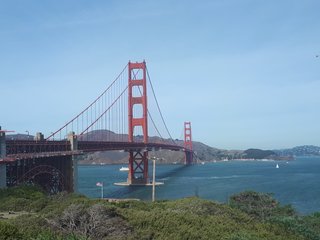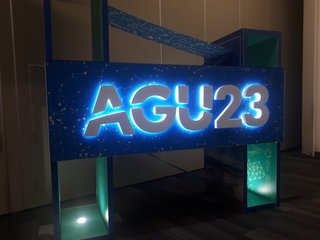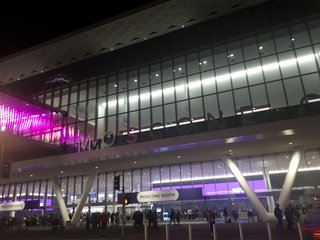Although nearly 25,000 scientists from all around the world have participated in the AGU Fall Meeting 2023 in San Francisco, crowds were spread out very well throughout the Moscone Center, San Francisco's largest convention hall. There were no large lines or overfilled rooms. This particularly good event organization can be traced back to the fact that the conference and especially the poster sessions are very logically structured based on the various research fields. Despite its wide span of geoscientific disciplines, ranging from Earth Interior, over Geo Health and Geoinformatics to Space Sciences, an orientation in the amazing poster hall with up to 4,000 posters each single day is straightforward. Thus, as a newcomer to this conference, it was very easy for me to connect with the community in my research field directly at my day of arrival. On the one hand, I could strengthen contacts to junior and senior scientists from Europe which I already know from previous meetings, but on the other hand, and even more important, I was able to significantly abandon my network to American scientists working on similar research topics. A great opportunity for networking activities in my open-minded community were the discussion rounds organized by my session conveners during the lunchbreaks in the sofa pods. The overall goal of these panels was to connect researchers in similar fields which were spread into five different (partially overlapping) oral and poster sessions with very similar topics. This was a great platform for getting in contact to scientists even from other sessions and meeting them continuously. Discussion rounds not only focussed on our specific methods and innovations in urban microclimatology, nature-based solutions for climate change adaptation and heat mitigation, but also on interdisciplinary outreach like knowledge transfer, citizen participation and community engagement. My 4.5-hour poster session was held on 12th of December. Despite this long time, my poster was highly frequented all over the session so that there were only around 3 minutes of gaps in total. During some times, up to 12 people were waiting for poster discussions. This clearly shows the high interest in my research topic and is a great experience for a junior scientist to contribute to this valuable scientific community. I received wonderful and extensive feedback, and my own research benefited from the fruitful discussions at this conference, as they helped me to reflect my methodological approaches and results of my microclimatological model simulations to adapt cities to climate change impacts. Thus, the broad scientific audience provided me with important suggestions, hints, ideas and perspectives for my ongoing research, especially by discussing my modelling outputs with experienced senior scientists in this fast-growing field of studies. During the other days, I really enjoyed visiting posters of other scientists which was a fantastic exchange and pool for new future cooperations. It was a great networking experience with a lot of new contacts, which also opened some doors for potential research stays abroad and post-doc opportunities at other institutions working in thematically and methodologically similar research fields. Together with other junior scientists, we were also collecting ideas for a common publication on model intercomparisons. One surprising highlight of this conference was also to meet again several scientists from NASA JPL which I already met some years ago during my research stay in Los Angeles. We also came up with ideas for further collaborations during this conference. Overall, my participation in the AGU was a key opportunity for me to extend my collaborative network beyond Europe, and my presence was a good chance to increase my international visibility. Beyond this, San Francisco was a wonderful host town, which welcomed us with a guest-friendly and particularly pedestrian-friendly cityscape as well as a very special atmosphere with all the AGU participants in this relatively small American downtown, but also with a very high price level especially for food. The exaggerated Christmas decorations seemed bizarre with the sunshine all over the week and almost 20 °C. I would like to thank the GSGS for this special opportunity.
Nils Eingrüber
PhD student
Institute of Geography
PhD project: “Modeling the urban microclimate of Cologne-Südstadt for climate change adaptation (MoMiKS)”
Poster Presentation: “High-Resolution Microclimate Modelling to Evaluate Urban Heat Mitigation Potentials of Rainfed Climate Change Adaptation Measures on Buildings under Various Climatic Conditions”


